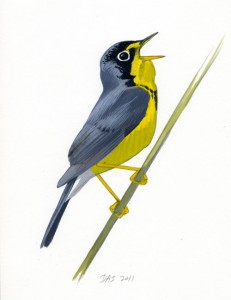In this discussion, tempo refers to the overall “pace” of the song, the number of notes or phrases per second. We describe this as fast or slow, and over the course of the whole song the tempo can be steady or variable. To be exact, tempo depends on the duration of notes, the duration of pauses between notes, the duration of different sections of the song, etc. For now, though, we will just be listening to the overall sound.
One of the simplest forms of bird song is the trill. Trills are comprised of a series of similar phrases, repeated rapidly on one pitch and at a steady rate. Pine Warbler is one of several species that is commonly heard giving trilled songs in Eastern North America.
The rate of phrases in the trill can be helpful for identifying the species, but details of the individual notes offer a more reliable way to identify the singer (more on that in a future post). The bird in the recording below alternates slow and fast trills, which can be confusing when you are trying to identify the species, but it’s a good opportunity to practice hearing the difference between faster and slower tempos.
Pine Warbler
Moving on to the more complex songs of other species, we can still hear obvious differences in tempo. Below are recordings of White-throated Sparrow and Canada Warbler. The song of Canada Warbler includes about the same number of phrases as White-throated Sparrow, but the phrases are much shorter and the whole song is delivered in about half the time. Adding to the impression of a very rapid delivery is the fact that the warbler’s phrases are sharply slurred, while the sparrow sings a series of clear whistles with no pitch change. We might describe the sparrow as “relaxed” and the warbler as “hurried”.
White-throated Sparrow
Canada Warbler
Finally, a more subtle example of different tempo is provided by the two species below (Song Sparrow and House Finch), Both sing varied songs – a mixture of clear whistled notes, trills, and buzzes – but the House Finch sings at a faster tempo. In addition to the overall rate of singing, the House Finch’s song is given as a headlong warble without pauses or dramatic changes in notes. The Song Sparrow is more measured, lingering on certain notes before moving deliberately and crisply to the next.
One way to notice the difference in tempo is to imagine that you are the conductor of the orchestra. Try holding up a finger and keeping time with the bird’s song.
Song Sparrow
House Finch
Tempo, like pitch, is usually not a field mark by itself, but paying attention to differences in tempo and the resulting rhythmic patterns is one of the keys to developing your bird song identification skills.
Recording credits
All of the recordings linked in this series are from the collection at Xeno-canto http://www.xeno-canto.org. This outstanding resource features the work of thousands of dedicated naturalists, all presented in an intuitive and functional website.



Nice lessons! It would help to add the sonograms alongside the recording so we can visualize the song at the same time.
Thank-you!
-jeff
Thanks Jeff, I agree that sonagrams would be helpful, but I think the little ones that come with the Xeno-canto links are too small and need some adjustments, and I haven’t had the time yet to create the ones I want. In the meantime if there is interest I can easily display the Xeno-canto images.
Remember to click on the Xeno-Canto sonogram and it will open in a larger pop-up window, also there is a option to see the whole recording visualized.
Stein, Tromsø, Norway
I am a music theory professor at the Cleveland Institute of Music and I also teach classes on bird song identification here in NE Ohio. Your approach is very similar to what I as an “ear trainer” use. We perceive bird song as music, and musical language works very well to describe and learn it.
I was surprised and very pleased to read about how you are presenting this material! I will absolutely refer my classes to this web site and if you publish a field guide/app I will refer them to that as well. Thank you so much for this excellent resource!
Lisa
I would love to find out what the bird is around here in southern Illinois. It makes this “hooooo HOOOO hoooo” sound, that sounds nothing like whistling. I listened to all the bird recordings I could find on here and I cannot locate the sound. I have never laid eyes on the bird, as it seems to frequent my neighbors backyard across the street. Is there a place where I can just listen to all the different bird noises to identify it?
Anyone know what Georgia bird’s tempo slows down at end? It’s not a cuckoo.